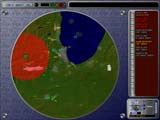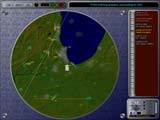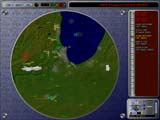 When I first fired Air Command 3.0 up for review, my
wife looked over my shoulder and asked what I was playing. "An air traffic control
game," I replied. She shook her head. "Like people don't get enough stress.
What's next? A dysfunctional workplace game?" While Air Command 3.0 isn't an
ultra-realistic simulation of a day in the life of an air traffic controller, it sure does
a good job of reproducing at least some of the job's pressures. In it, you control the
airspace around one of several major international airports, and when you begin trying to
coordinate landings and take-offs at several regional airports while steering dozens of
jets and Piper Cubs to VORs and vectoring in 747s for landings, you'll start to
feel a little harassed. In a good way. When I first fired Air Command 3.0 up for review, my
wife looked over my shoulder and asked what I was playing. "An air traffic control
game," I replied. She shook her head. "Like people don't get enough stress.
What's next? A dysfunctional workplace game?" While Air Command 3.0 isn't an
ultra-realistic simulation of a day in the life of an air traffic controller, it sure does
a good job of reproducing at least some of the job's pressures. In it, you control the
airspace around one of several major international airports, and when you begin trying to
coordinate landings and take-offs at several regional airports while steering dozens of
jets and Piper Cubs to VORs and vectoring in 747s for landings, you'll start to
feel a little harassed. In a good way.Air
Command 3.0 is a simple game in an elegant and Thoreauesque kind of way. The
graphics aren't 3D, there's only one screen, and the action mostly consists of watching
radar icons move slowly across your screen while you issue a limited set of orders to
them. That's all there is, but that's all you need for a very rewarding gaming experience.
 In
Air Command 3.0, you take the role of an air traffic controller working his or her way
through their shift. There are no career or multiplayer modes, and each game takes about
thirty minutes or so. The better you do, the higher score you get. The game is played on a
single radar screen that overlays a map of your airport's airspace, and shows both other
local airports and VORs (VHF Omni-directional receiver, used to direct aircraft merely
passing through your airspace), as well as the icons of any aircraft in your area. As your
shift begins, a few planes will appear on your screen. Their paths to their destinations
(either airport or VOR) will be plotted, and you'll typically only have to set their speed
(to avoid collisions with other aircraft) and their altitude in increments of 1,000 feet
(you want it high for planes passing through to VORs, low if they're coming in for
landings, in-between to avoid congestion at either of the other levels). As your shift
progresses, more planes will appear, you'll be asked to give permissions for takeoffs and
landings, and you'll occasionally have to vector planes in to airports or direct them off
their preset routes. Sounds simple, but it gets very complex when suddenly several planes
want to leave at the same VOR at the same time and altitude, or if a plane wants to land
when another wants to take off, or when you have to reset a plane's direction because its
landing approach is coming from the wrong quarter--or when--worst of all--a pilot
misunderstands your directions and lays your well-laid plans to waste. If you screw up,
well, you might just make a plane land a half-hour or so late. Like that never happens. On
the other hand, during very congested periods it's entirely possible to suddenly find two
planes on a collision course that you just hadn't anticipated. In
Air Command 3.0, you take the role of an air traffic controller working his or her way
through their shift. There are no career or multiplayer modes, and each game takes about
thirty minutes or so. The better you do, the higher score you get. The game is played on a
single radar screen that overlays a map of your airport's airspace, and shows both other
local airports and VORs (VHF Omni-directional receiver, used to direct aircraft merely
passing through your airspace), as well as the icons of any aircraft in your area. As your
shift begins, a few planes will appear on your screen. Their paths to their destinations
(either airport or VOR) will be plotted, and you'll typically only have to set their speed
(to avoid collisions with other aircraft) and their altitude in increments of 1,000 feet
(you want it high for planes passing through to VORs, low if they're coming in for
landings, in-between to avoid congestion at either of the other levels). As your shift
progresses, more planes will appear, you'll be asked to give permissions for takeoffs and
landings, and you'll occasionally have to vector planes in to airports or direct them off
their preset routes. Sounds simple, but it gets very complex when suddenly several planes
want to leave at the same VOR at the same time and altitude, or if a plane wants to land
when another wants to take off, or when you have to reset a plane's direction because its
landing approach is coming from the wrong quarter--or when--worst of all--a pilot
misunderstands your directions and lays your well-laid plans to waste. If you screw up,
well, you might just make a plane land a half-hour or so late. Like that never happens. On
the other hand, during very congested periods it's entirely possible to suddenly find two
planes on a collision course that you just hadn't anticipated.
 These
moments will come fast and furious as your shift progresses, and when they do you'll be
very happy with the game's very elegant interface, which allows you to remedy most of
these situations with a quick click or hotkey stroke. The interface is spare but
effective, and so are the game's graphics, which are not unattractive and get the job
done. You can set the game's res as high as 1024 x 768, and choose to use several
different map overlays. As for the game's sound, well, the voices of the airline pilots
offer helpful information and ask for permission to take off, but they sound very much
alike (as Tom Wolfe points out in The Right Stuff, most airline pilots do Chuck
Yeager imitations) and are a little too easy to ignore. On the other hand, the best thing
about the game's midi music soundtrack is that it can be turned off. These
moments will come fast and furious as your shift progresses, and when they do you'll be
very happy with the game's very elegant interface, which allows you to remedy most of
these situations with a quick click or hotkey stroke. The interface is spare but
effective, and so are the game's graphics, which are not unattractive and get the job
done. You can set the game's res as high as 1024 x 768, and choose to use several
different map overlays. As for the game's sound, well, the voices of the airline pilots
offer helpful information and ask for permission to take off, but they sound very much
alike (as Tom Wolfe points out in The Right Stuff, most airline pilots do Chuck
Yeager imitations) and are a little too easy to ignore. On the other hand, the best thing
about the game's midi music soundtrack is that it can be turned off.
The game's manual is short, to the point, and
thorough, and AC3 allows you to play and several difficulty levels (including custom) and
also comes with an easy-to-use editor that lets you to build your own airports.
If you're looking for a state-of-the-art
quick-twitch graphics-laden monster of a game, AC3 isn't gonna get it. But if you're
in the market for a tense, thoughtful, and fun gaming experience that takes less time to
play than most games take to install, Air Command 3.0 is well worth your time and money.
Rick
Fehrenbacher |
